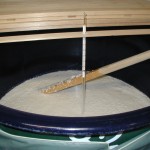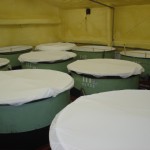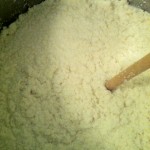The sake-brewing process is fairly idiosyncratic. No other alcoholic beverage in the world is brewed quite like sake is. Perhaps the most obvious difference is that the ingredients are added in stages. The first two to four weeks see the creation of a yeast starter, to secure a high population of yeast cells, and after that, the rest of the ingredients are added, again, in stages.
brewed quite like sake is. Perhaps the most obvious difference is that the ingredients are added in stages. The first two to four weeks see the creation of a yeast starter, to secure a high population of yeast cells, and after that, the rest of the ingredients are added, again, in stages.
How many stages? Three. Hence the term sandan-shikomi, or “adding ingredients in three stages.”
Once the yeast starter is ready, more rice, water and koji (the moldy rice within which enzymes develop that chop the starch in the rice into sugar for the yeast) are added to that small tank, which was itself created with the same three ingredients.
But it is not all added at once. After the starter has been prepared, enough rice, water and koji are added to roughly double the size of the batch. After letting that sit two days, the size of the batch is again doubled. And, one day later, more ingredients are added to again double the existing size of the batch. So in the end, the yeast starter is about an eighth or so of the final size of the batch. (This will of course vary a bit from place to place.)
koji are added to roughly double the size of the batch. After letting that sit two days, the size of the batch is again doubled. And, one day later, more ingredients are added to again double the existing size of the batch. So in the end, the yeast starter is about an eighth or so of the final size of the batch. (This will of course vary a bit from place to place.)
What’s the point? Why not just dump it in there all at once, and be done with it? It comes down to strength and vulnerability of the yeast.
Bear in mind that there are only so many yeast cells in the yeast starter. Sure, it is like 200 million per cc of liquid, but apparently that is not enough. If that mixture is thinned out too much, then the yeast becomes vulnerable to all kinds of things, from wild yeasts in the environment that will not lead to tasty sake, to other micro-organisms that can adversely affect or stop fermentation of the mash.
So one reason to add the rice, water and koji more slowly is to let the yeast catch up. It will reproduce at its own pace and thereby keep its strength in numbers and its ability to fend off less desirable micro-organisms. It helps reduce the vulnerability of the yeast.
Another way to look at it is in terms of strength. If all the rice, water and koji were add at once the yeast would either be overwhelmed by the sugar and eventually peter out before completing its job. Slowly adding it all lets the yeast handle it better. It is a bit like starting a fire: if you take a match and try to start a big log, your chances of success are not nearly as high as if you use some proper kindling, like leaves and small sticks.
Of course, these days, we can indeed light a big log on fire; all we need is something like a blowtorch or a good dose of chemicals. And, the equivalent of a yeast blowtorch exists in the sake world as well! It’s called kobo-jikomi, or yeast infusion (translation mine).
 And it is what it sounds like: no yeast starter is used; instead, a comparatively huge amount of pure yeast is added to the batch right away, allowing it to ferment a full tank right off the bat. In truth, very little sake is made this way, and it is usually cheaper sake made in huge batches. It is a perfectly valid way to make sake, and the resulting sake is often quite good.
And it is what it sounds like: no yeast starter is used; instead, a comparatively huge amount of pure yeast is added to the batch right away, allowing it to ferment a full tank right off the bat. In truth, very little sake is made this way, and it is usually cheaper sake made in huge batches. It is a perfectly valid way to make sake, and the resulting sake is often quite good.
But it is almost never seen in smaller batches, smaller breweries, or premium sake.
So, the hassle-laden sandan-shikomi process of adding the ingredients in three stages is the traditional way to make sake, and one that is in fact unique to sake, and is done to help keep the yeast safe and active. That’s the point.
Check out my new book, Sake Confidential
http://www.cbsdsmarttools.com/sites/m98110/index.html




